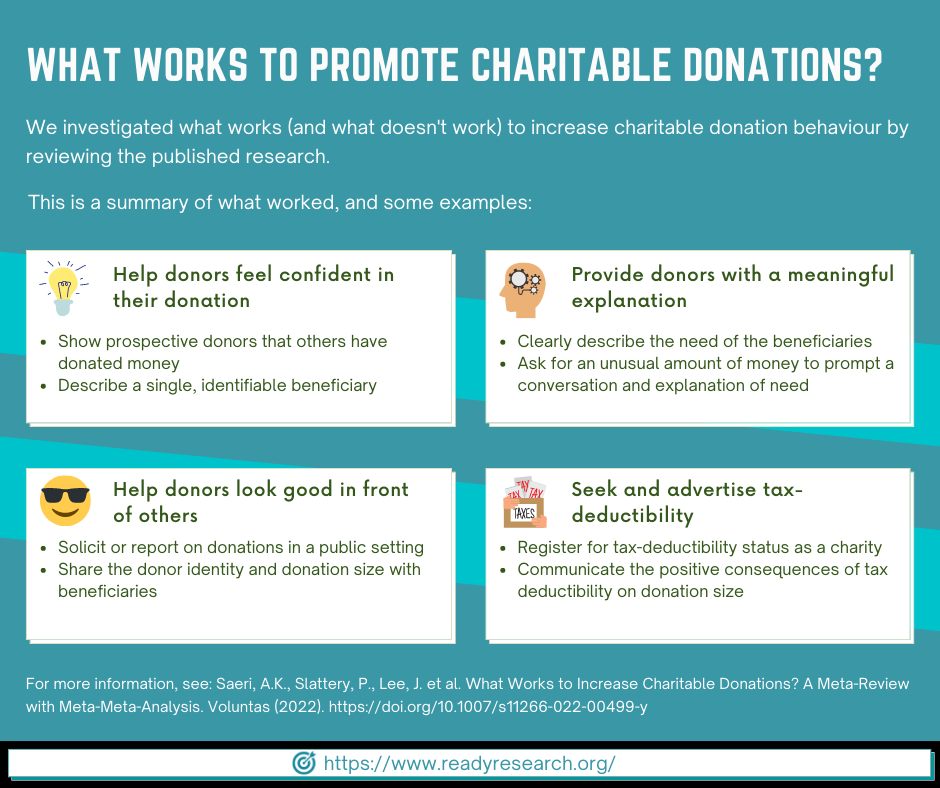Ready Research (formerly the Rapid Effective Action Development Initiative) recently completed a meta-review of interventions to promote charitable donations.
The work was led by Alexander Saeri and conducted in collaboration with a team of EA-aligned researchers and organisations.
The review in brief
We investigated what works (and what doesn't work) to increase charitable donation behaviour by collating the highest quality existing published research. We found that charities could increase donations by (1) helping donors feel confident in their donation, (2) providing donors with a meaningful explanation for why their donation is needed, (3) helping donors look good in front of others, and (4) seeking and advertise tax deductibility.
Why did we do this review?
If we can convince people to donate more, and donate more effectively, we can better promote flourishing & reduce suffering. A lot of work done by charities to encourage donations is based on intuitions or sometimes research from marketing. But just as some charities are significantly more effective than others, we believe that some interventions to promote charitable donations could be significantly more effective than others. In this review, we try to identify and recommend those effective interventions.
What did we do in this review?
This review of systematic reviews ("meta-review") examined which interventions increase the size or likelihood of charitable donations (the altruistic transfer of money from a person to an organisation that helps people in need). We also tried to estimate the size of the impact of different interventions on donation behaviour by combining other estimates reported in previous research ("meta-meta-analysis").
What research did we find?
We synthesised evidence from 21 systematic reviews, some of which included meta-analyses. These reviews represent 1,339 individual studies and more than 2 million people and were published before March 2021. We found 13 different types of interventions to promote charitable giving. Some examined the donation size, and others examined donation likelihood (e.g., to donate vs. not donate at all).
Across all studies and interventions, the average effect size was r = 0.08, 95% CI [0.03, 0.12], K = 23. This means that choosing an intervention at random out of those we catalogued, you would expect an increase in donation size or likelihood for 1 out of every 21 people. Some interventions were much more effective than others. The best interventions increased donation size or likelihood for between 1 in 7 people and 1 in 12 people.
Recommendations for charities and practitioners
What worked
| Recommendation | Examples of strategies that worked | Increased donation size / likelihood |
| Help donors feel confident in their donation | Showing prospective donors that others have donated money | 1 in 7 people |
| Describing a single, identifiable beneficiary | 1 in 12 people | |
| Provide donors with a meaningful explanation for why their donation is needed | Clearly describing the need of the beneficiaries | 1 in 12 people |
| Responsibly using tactics to start a conversation about the donation need, such as by asking for a strange (17c) or very small (1c) amount of money | 1 in 6 people | |
| Help donors look good in front of others | Soliciting or reporting on donations in a public setting (while avoiding guilt or social pressure) Sharing the donor identity and donation size with beneficiaries Emphasising personal pride and self-efficacy through transparency of reporting and to establish a positive social norm of giving | 1 in 11 people |
| Seek and advertise tax deductibility | Registering for tax-deductibility status as a charity Communicating the positive consequences of tax-deductibility on donation size | Tax deduction of $1 led to additional $1.44 in donations |
What didn't work
| Recommendation | What we found |
| Donation matching |
|
| Asking for a large donation first, then asking for a smaller amount after refusal |
|
| Using artificial cues (e.g., pictures of eyes) |
|
| Encouraging snap judgements |
|
Recommendations for researchers and funders
| Recommendation | How to do it / considerations |
| Systematically review topics of practical relevance |
|
| Publish randomised field trials (e.g., A/B tests) that examine real behaviour and easily translatable research |
|
| Assess determinants of effective giving (e.g, giving to highly effective charities) |
|
Infographic/visual summary

Where to get further information?
Read the peer-reviewed paper for free at Voluntas: International Journal of Voluntary & Nonprofit Organisations:
Saeri, A. K., Slattery, P., Lee, J., Houlden, T., Farr, N., Gelber, R. L., Stone, J., Huuskes, L., Timmons, S., Windle, K., Spajic, L., Freeman, L., Moss, D., Behar, J., Schubert, S., Grundy, E. A. C., Zorker, M. (2022). What Works to Increase Charitable Donations? A Meta-Review with Meta-Meta-Analysis. Voluntas: International Journal of Voluntary and Nonprofit Organizations. doi: 10.1007/s11266-022-00499-y
Feedback
If you have any feedback on this post, our research, or anything else, then please complete our short feedback form or comment below. We would really appreciate hearing if you found it useful.
What is Ready Research?
Ready Research coordinates and conducts behaviour science research to improve decision-making and behaviour for the world's most pressing problems. In this project, we recruited and trained interested volunteers in research methods and writing, and convened an advisory group of charity experts and practitioners who provided advice on the research protocol and where & how to communicate the findings. You can visit our website, readyresearch.org; email the project lead, Michael Noetel; or email the primary author of the peer-reviewed paper, Alexander Saeri.
Opportunities to engage with future research
Our next project is likely to focus on Improving Institutional Decision Making (IIDM).
If you would like to lead, or supervise, a project, or get research experience as a junior researcher, then please submit your details to our collaborator database and we will notify you if an opportunity emerges. Our next project will examine institutional decision-making.
Acknowledgements
We would like to thank everyone involved in completing and supporting the research.
